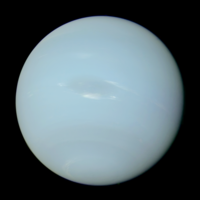
Photo from wikipedia
Sea ice estimates from AMSR2 are intercalibrated with AMSR-E fields through a two-step process. First, slow rotation 2 r/min AMSR-E data is used to derive regression equations from colocated pairs of… Click to show full abstract
Sea ice estimates from AMSR2 are intercalibrated with AMSR-E fields through a two-step process. First, slow rotation 2 r/min AMSR-E data is used to derive regression equations from colocated pairs of AMSR2 and AMSR-E brightness temperatures (Tbs). The regression equations are used to modify AMSR2 Tbs into AMSR-E equivalent Tbs that are then input into the NASA Team 2 (NT2) sea ice concentration algorithm used for the AMSR-E standard products. The regressed Tbs result in changes in sea ice concentration of a few percent compared to using the original un-regressed AMSR2 Tbs. Next, sea ice estimates from the F17 SSMIS sensor are used as a bridge to compare AMSR-E total sea ice extent estimates in 2010 with AMSR2 total sea ice extent estimates in 2013. Based on this comparison, a further adjustment is made to a weather filter threshold used in the NT2 algorithm to minimize the total extent bias between AMSR2 and AMSR-E using a double-differencing approach. The adjustments reduced apparent bias with AMSR-E from ∼200 000 km2 for the original unmodified AMSR2 Tbs to –700 and 4700 km2 for the Arctic and Antarctic, respectively. These differences are within the range of previous passive microwave sea ice intercalibrations. The adjusted AMSR2 sea ice fields provide a nearly 15-year time series of sea ice change; depending on the lifetime of AMSR2 and possible follow-on sensors, AMSR2 has the potential to be part of a multidecadal record of sea ice change.
Journal Title: IEEE Journal of Selected Topics in Applied Earth Observations and Remote Sensing
Year Published: 2017
Link to full text (if available)
Share on Social Media: Sign Up to like & get
recommendations!